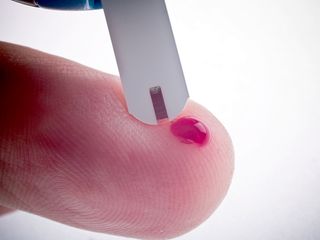Drug May Prevent Diabetes in High-Risk People

Patients at high risk for developing Type 2 diabetes may be able to take a daily pill to prevent the disease, according to a new study.
The drug, called pioglitazone, was able to reduce the risk of developing Type 2 diabetes by 72 percent in patients with prediabetes.
Prediabetes is a condition in which individuals have abnormally high glucose levels, but not yet high enough to be considered to have diabetes. About 79 million Americans have prediabetes, according to the American Diabetes Association. Individuals with this condition are not only at risk for diabetes, but also for other cardiovascular complications, which can lead to heart attacks and stroke.
Other therapies, including drugs, diet and exercise, can reduce the chance that someone will progress from prediabetes to diabetes. But no other therapy has been able to reduce the risk by this much, said study researcher Dr. Ralph DeFronzo, chief of the diabetes division at the University of Texas Health Science Center in San Antonio. Patients should attempt lifestyle changes before they go on medication, said study researcher Devjit Tripathy, also of UT Health Science Center. But patients often do not comply with such regimens.
The reduction in diabetes development seen in this study is "very impressive," said Dr. Jill Crandall, a diabetes researcher at the Albert Einstein College of Medicine in New York City who was not involved in the study. However, pioglitazone is already used as a treatment for diabetic patients, and so its effect on prediabetes "really is not a surprise," Crandall said.
In addition, patients in the study only took the drug for an average of 2.4 years. More research is needed looking into the long-term effects of this drug, Crandall said. As of now, the drug has not demonstrated enough benefit to recommend it for routine use, she said.
"Lifestyle change, such as weight loss and exercise, remains the best option for those who can do it," she said.
Sign up for the Live Science daily newsletter now
Get the world’s most fascinating discoveries delivered straight to your inbox.
The study will be published March 24 in the New England Journal of Medicine.
Treating prediabetes
Type 2 diabetes occurs when the body does not properly respond to insulin. This hormone is needed to get sugar, or glucose, into cells. By the time Type 2 diabetes develops, the cells are resistant to insulin, and sugar builds up in the blood stream.
Pioglitazone makes the body more sensitive to insulin and lowers blood glucose levels.
In the new study, 604 patients with prediabetes were randomly assigned to take either pioglitazone or a placebo once a day. Participants also had other risk factors for diabetes, including obesity and a family history of the disease.
After patients had received treatment for an average of 2.4 years, 5 percent of patients in the pioglitazone group developed diabetes, compared with 16.7 percent of patients in the placebo group.
Eighteen people would need to be treated for one year with this drug to prevent one case of diabetes, the researchers say.
Pioglitazone lowered blood pressure and increased the amount of "good" cholesterol in patients more than did the placebo. The drug also reduced the rate of thickening of the carotid artery, a blood vessel that supplies blood to the brain. This indicates that patients' blood glucose levels are well controlled, the researchers say.
But the drug has side effects. It is associated with weight gain and edema, or swelling due to fluid retention. The weight gain arises because the drug improves the functionality and growth of new fat cells, said Dr. Harold Bays, medical director of the Louisville Metabolic and Atherosclerosis Research Center Inc., who was not involved in the study. In patients with metabolic disease, fat cells become large and don't work properly, Bays said. So in this case, adding new fat cells that work better can lower blood glucose levels, he said.
Lingering questions
An important question the study did not answer is: What happens when patients are taken off the drug?
"What I would want to know is, six months after you stopped pioglitazone, six months after you've stopped an approved treatment for diabetes mellitus, what happened to these people's glucose levels?" Bays said. He points out that one definition of the term "prevention" would be an intervention that did not require patients to be treated with a drug that is also given for diabetes.
In addition, researchers still don't know whether treating prediabetes is more effective than treating people after they have developed diabetes in terms of preventing unwanted outcomes, including eye, kidney, heart and nerve complications, Crandall said.
"From a public health point of view, this is critical," Crandall said. "If we adopted the approach of using [pioglitazone] for diabetes prevention, we could potentially be treating millions of people over many, many years with an expensive drug — without knowing if it ultimately would provide significant benefit."
Pass it on: Pioglitazone may prevent diabetes in at-risk patients, but more research is needed into the long-term effects of the drug.
Follow MyHealthNewsDaily staff writer Rachael Rettner on Twitter @RachaelRettner.

Rachael is a Live Science contributor, and was a former channel editor and senior writer for Live Science between 2010 and 2022. She has a master's degree in journalism from New York University's Science, Health and Environmental Reporting Program. She also holds a B.S. in molecular biology and an M.S. in biology from the University of California, San Diego. Her work has appeared in Scienceline, The Washington Post and Scientific American.
Most Popular

